STAR GNSS-RO Data Services
COSMIC-2
FormoSat-7 (Formosa Satellite 7) / COSMIC-2 (Constellation Observing System for Meteorology, Ionosphere and Climate)
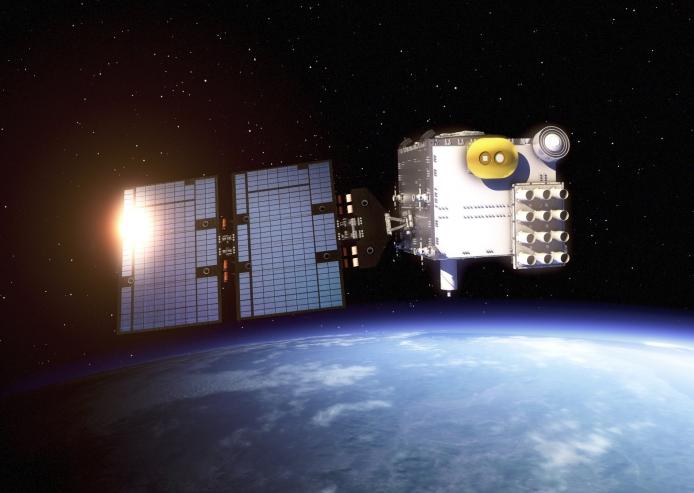 COSMIC-2 also known as FORMOSAT-7, is
the constellation of satellites for meteorology, ionosphere, climatology, and space weather research.
FORMOSAT-7 is a joint US-Taiwanese project including National Space Organization (NSPO) on the
Taiwanese side and the National Oceanic and Atmospheric Administration (NOAA) and the United States
Air Force (USAF) on the US side. FORMOSAT-7 is the successor of FORMOSAT-3. The six satellites of the
constellation were launched 25 June 2019 on a Falcon Heavy rocket. They reached their designated
mission orbits in February 2021, after eighteen months of gradual orbital adjustments.This team of
COSMIC satellites circles the equator at approximately 17,000 miles per hour and uses a technique
called radio occultation to collect information on our planet’s atmosphere. Here’s how it works:
Global Positioning System (GPS) satellites constantly send signals down to receivers on Earth, but
those signals get distorted along the way because the density of Earth’s atmosphere changes with
height. COSMIC-2 satellites can detect and measure any small bends in those signals before they are
cut off by Earth’s horizon. The three-minute period before the radio signal is cut off is known as
radio occultation, and that data are what gives scientists near real-time information about the
Earth’s atmosphere including conditions such as: temperature, pressure, density and water vapor.
COSMIC-2 also known as FORMOSAT-7, is
the constellation of satellites for meteorology, ionosphere, climatology, and space weather research.
FORMOSAT-7 is a joint US-Taiwanese project including National Space Organization (NSPO) on the
Taiwanese side and the National Oceanic and Atmospheric Administration (NOAA) and the United States
Air Force (USAF) on the US side. FORMOSAT-7 is the successor of FORMOSAT-3. The six satellites of the
constellation were launched 25 June 2019 on a Falcon Heavy rocket. They reached their designated
mission orbits in February 2021, after eighteen months of gradual orbital adjustments.This team of
COSMIC satellites circles the equator at approximately 17,000 miles per hour and uses a technique
called radio occultation to collect information on our planet’s atmosphere. Here’s how it works:
Global Positioning System (GPS) satellites constantly send signals down to receivers on Earth, but
those signals get distorted along the way because the density of Earth’s atmosphere changes with
height. COSMIC-2 satellites can detect and measure any small bends in those signals before they are
cut off by Earth’s horizon. The three-minute period before the radio signal is cut off is known as
radio occultation, and that data are what gives scientists near real-time information about the
Earth’s atmosphere including conditions such as: temperature, pressure, density and water vapor.
- Level 2
- Atmospheric profiles
KOMPSAT5
The KOMPSAT-5 (Arirang-5) spacecraft was launched on August 22, 2013 on a Dnepr-1 launch vehicle of ISC Kosmotras from the Dombarovsky Launch Site, Yasny, Russia.
 The goal of the KOMPSAT 5 (Korean Multi-purpose Satellite 5) or Arirang 5 project is to lead the
development of the first Korean SAR Satellite using manpower and facilities from the KOMPSAT-3
program. It aims to support the national SAR (Synthetic Aperture Radar) satellite demand and form a
technology infrastructure to make inroads into the world space industry.
KOMPSAT-5, which was developed since in the middle of 2005, was launched in 2014 and its payload is a
X-band SAR a, which operates at Dawn-Dusk orbit between an altitude of 500 km to 600 km.
It executes all weather and all day observations of the Korean peninsula during its five year mission
using the SAR payload, unlike the optical KOMPSAT-1, -2 and -3 satellites. And in order to meet the
urgent national needs for various SAR image information, the KOMPSAT-5 GOLDEN Mission will provide GIS
(Geographical Information Systems), Ocean monitoring, Land management, Disaster monitoring, and
Environment monitoring.
The primary mission of the KOMPSAT-5 system is to provide high resolution mode SAR images of 1 meter
resolution, standard mode SAR images of 3 meter resolution and wide swath mode SAR images of 20 meter
resolution with viewing conditions of the incidence angle of 45 degrees using the COSI (COrea SAR
Instrument) payload, for meeting GOLDEN mission objectives.
The secondary mission of KOMPSAT-5 is to generate the atmospheric sounding profile and support radio
occultation science using AOPOD (atmospheric occultation and precision orbit determination) secondary
payload which is composed of a dual frequency GPS receiver and a laser retroreflector array (LRRA).
The goal of the KOMPSAT 5 (Korean Multi-purpose Satellite 5) or Arirang 5 project is to lead the
development of the first Korean SAR Satellite using manpower and facilities from the KOMPSAT-3
program. It aims to support the national SAR (Synthetic Aperture Radar) satellite demand and form a
technology infrastructure to make inroads into the world space industry.
KOMPSAT-5, which was developed since in the middle of 2005, was launched in 2014 and its payload is a
X-band SAR a, which operates at Dawn-Dusk orbit between an altitude of 500 km to 600 km.
It executes all weather and all day observations of the Korean peninsula during its five year mission
using the SAR payload, unlike the optical KOMPSAT-1, -2 and -3 satellites. And in order to meet the
urgent national needs for various SAR image information, the KOMPSAT-5 GOLDEN Mission will provide GIS
(Geographical Information Systems), Ocean monitoring, Land management, Disaster monitoring, and
Environment monitoring.
The primary mission of the KOMPSAT-5 system is to provide high resolution mode SAR images of 1 meter
resolution, standard mode SAR images of 3 meter resolution and wide swath mode SAR images of 20 meter
resolution with viewing conditions of the incidence angle of 45 degrees using the COSI (COrea SAR
Instrument) payload, for meeting GOLDEN mission objectives.
The secondary mission of KOMPSAT-5 is to generate the atmospheric sounding profile and support radio
occultation science using AOPOD (atmospheric occultation and precision orbit determination) secondary
payload which is composed of a dual frequency GPS receiver and a laser retroreflector array (LRRA).
- Level 2
- Atmospheric profiles
PAZ
PAZ was launched on 22 February 2018 from Vandenberg, Space Launch Complex 4
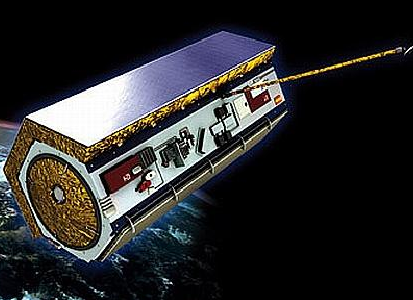 Paz (Spanish for "Peace") is a Spanish Earth observation and reconnaissance satellite launched on 22
February 2018. It is Spain's first spy satellite.The satellite is operated by Hisdesat.Paz was
previously referred to as SEOSAR (Satélite Español de Observación SAR).
For observational purposes, Paz uses a synthetic aperture radar (SAR) to collect images of Earth for
governmental and commercial use, as well as other ship tracking and weather sensors, which enables
high-resolution mapping of large geographical areas at day and night. The X-band radar imaging payload
operates at a wavelength of 3.1 centimetres (1.2 in), or a frequency of 9.65 gigahertz.
The Paz satellite is operated in a constellation with the German SAR fleet TerraSAR-X and TanDEM-X on
the same orbit. The collaboration was agreed on by both Hisdesat and former European aerospace
manufacturer Astrium, operator of the two other satellites. The high-resolution images will be used
for military operations, border control, intelligence, environmental monitoring, protection of natural
resources, city, and infrastructure planning, and monitoring of natural catastrophes.
Originally, Paz was scheduled for launch from the Yasny launch base, Russia, in 2014, but this was
delayed due to Russia's 2014 annexation of Crimea, resulting in an International Court of Arbitration
legal battle between Hisdesat and Kosmotras. The US launch was estimated to cost around €53 million,
cost partially reduced by the inclusion of several mobile internet satellites on the same flight.
Paz (Spanish for "Peace") is a Spanish Earth observation and reconnaissance satellite launched on 22
February 2018. It is Spain's first spy satellite.The satellite is operated by Hisdesat.Paz was
previously referred to as SEOSAR (Satélite Español de Observación SAR).
For observational purposes, Paz uses a synthetic aperture radar (SAR) to collect images of Earth for
governmental and commercial use, as well as other ship tracking and weather sensors, which enables
high-resolution mapping of large geographical areas at day and night. The X-band radar imaging payload
operates at a wavelength of 3.1 centimetres (1.2 in), or a frequency of 9.65 gigahertz.
The Paz satellite is operated in a constellation with the German SAR fleet TerraSAR-X and TanDEM-X on
the same orbit. The collaboration was agreed on by both Hisdesat and former European aerospace
manufacturer Astrium, operator of the two other satellites. The high-resolution images will be used
for military operations, border control, intelligence, environmental monitoring, protection of natural
resources, city, and infrastructure planning, and monitoring of natural catastrophes.
Originally, Paz was scheduled for launch from the Yasny launch base, Russia, in 2014, but this was
delayed due to Russia's 2014 annexation of Crimea, resulting in an International Court of Arbitration
legal battle between Hisdesat and Kosmotras. The US launch was estimated to cost around €53 million,
cost partially reduced by the inclusion of several mobile internet satellites on the same flight.
- Level 2
- Atmospheric profiles
PlanetiQ
Space Sciences and Engineering LLC dba PlanetiQ (Golden, CO)
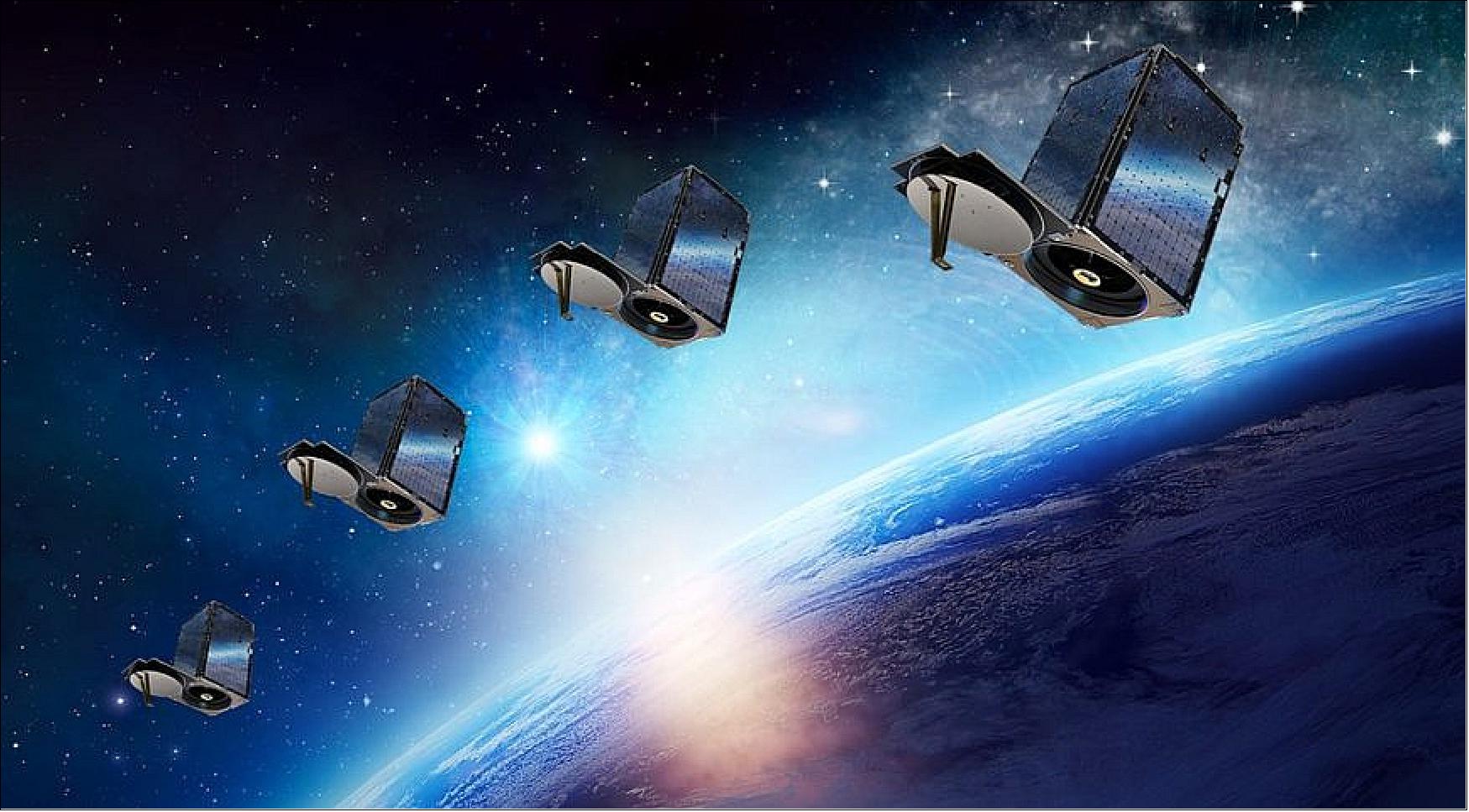 On November 26, 2013, Planet Labs, a private start-up company of San Francisco, CA, announced that it successfully launched its most recent nanosatellites, Dove 3 and Dove 4, into orbit on a Dnepr vehicle (launch on Nov. 21, 2013 from the Yasny Cosmodrome, Russia), completing a series of four prototype nanosatellites in 2013. Those proved successful, enabling the company to quickly follow up with the production of a 28-member network. The launch of Planet Labs’ "Flock 1" fleet of 28 nanosatellites in December/January, which will be the largest constellation of Earth-imaging satellites ever launched.
On March 23, 2023, NOAA announced the award of RODB-2 IDIQ contracts to PlanetiQ and to Spire Global Subsidiary. These contracts, with a total maximum value of $60M, have a five-year ordering period. Because the IDIQ contract duration is five years, while developing the RODB-2 RFP, NOAA’s CDP decided to annually pulse the commercial sector to see if new vendors have emerged that are capable of meeting RODB-2 requirements.
On November 26, 2013, Planet Labs, a private start-up company of San Francisco, CA, announced that it successfully launched its most recent nanosatellites, Dove 3 and Dove 4, into orbit on a Dnepr vehicle (launch on Nov. 21, 2013 from the Yasny Cosmodrome, Russia), completing a series of four prototype nanosatellites in 2013. Those proved successful, enabling the company to quickly follow up with the production of a 28-member network. The launch of Planet Labs’ "Flock 1" fleet of 28 nanosatellites in December/January, which will be the largest constellation of Earth-imaging satellites ever launched.
On March 23, 2023, NOAA announced the award of RODB-2 IDIQ contracts to PlanetiQ and to Spire Global Subsidiary. These contracts, with a total maximum value of $60M, have a five-year ordering period. Because the IDIQ contract duration is five years, while developing the RODB-2 RFP, NOAA’s CDP decided to annually pulse the commercial sector to see if new vendors have emerged that are capable of meeting RODB-2 requirements.
- Level 2
- Atmospheric profiles
GeoOptics
CICERO (Community Initiative for Continuing Earth Radio Occultation)
 CICERO satellites perform GNSS-RO of Earth's atmosphere and surface remote sensing by GNSS reflection and obtain data for weather forecasting, climate research, and space weather monitoring.
CICERO satellites perform GNSS-RO of Earth's atmosphere and surface remote sensing by GNSS reflection and obtain data for weather forecasting, climate research, and space weather monitoring.
- Level 2
- Atmospheric profiles
Spire
Spire Global Nanosatellite Constellation
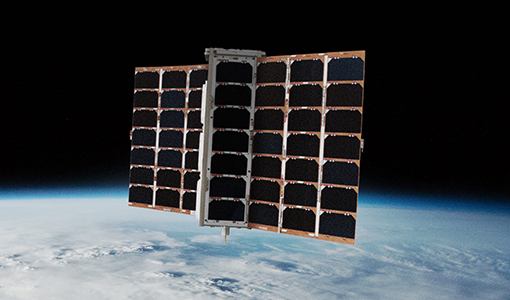 In 2014, commercial company Spire Global inaugurated the Lemur project with the launch of the Low Earth Multi-Use Receiver-1 (Lemur-1) prototype satellite on a Soyuz Rocket. The main objective of the mission was to demonstrate the satellite platform and support systems. Lemur-2 is a constellation of nano-satellites with 3U CubeSat platforms, designed to maintain up to 175 flight units. The program began in 2015 with the launch of four Lemur-2 nanosatellites, and a total of 156 flight units have been launched as of May 2022. Lemur-2 images are used to track maritime, aviation, and weather activity from space.
In 2014, commercial company Spire Global inaugurated the Lemur project with the launch of the Low Earth Multi-Use Receiver-1 (Lemur-1) prototype satellite on a Soyuz Rocket. The main objective of the mission was to demonstrate the satellite platform and support systems. Lemur-2 is a constellation of nano-satellites with 3U CubeSat platforms, designed to maintain up to 175 flight units. The program began in 2015 with the launch of four Lemur-2 nanosatellites, and a total of 156 flight units have been launched as of May 2022. Lemur-2 images are used to track maritime, aviation, and weather activity from space.
- Level 2
- Atmospheric profiles
GRAS
MetOp (Meteorological Operational Satellite Program of Europe)
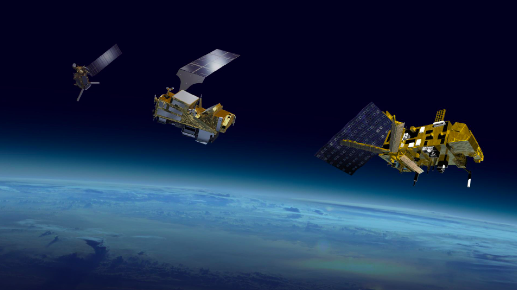 The Meteorological Operational satellite program (MetOp) is a collaboration between the European Space Agency (ESA) and the European Organisation for the Exploitation of Meteorological Satellites (EUMETSAT) with the aim to provide satellite observation and data services for weather prediction and climate monitoring. MetOp provides temperature and humidity profiles on the atmosphere, as well as wind speed and direction above the ocean data for Numerical Weather Prediction (NWP). MetOp-A, launched in 2006 and retired in 2021, began the MetOp series, followed by the launches of MetOp-B and -C in 2012 and 2018, respectively.
The MetOp satellites are identical in design, each carrying 11 instruments which provide data for weather predictions. Infrared Atmospheric Sounding Interferometer (IASI) measures infrared radiation emitted from Earth’s surface to derive data on humidity and atmospheric temperature profiles in the troposphere and lower stratosphere. Microwave Humidity Sounder (MHS) measures microwave radiation emitted from Earth’s surface to acquire measurements at various altitudes of atmospheric humidity, including rain, snow, hail, sleet, and temperature. Global Navigation Satellite System Receiver for Atmospheric Sounding (GRAS) operates as an atmospheric-sounding instrument that supplies atmospheric soundings of the temperature and humidity of the Earth’s atmosphere.
Advanced Scatterometer (ASCAT) measures wind speed and direction over the ocean. Global Ozone Monitoring Experiment-2 (GOME-2) is a spectrometer that collects light arriving from the Sun-illuminated Earth’s atmosphere or a direct view to the Sun and decomposes it into its spectral components to derive a detailed picture of the atmospheric content and profile of certain atmospheric components. Advanced Microwave Sounding Units (AMSU-A1 and AMSU-A2) measure scene radiance in the microwave spectrum. High Resolutions Infrared Radiation Sounder (HIRS/4) is a 20-channel radiometric sounder measuring radiance in the infrared spectrum. Data from the AMSU instruments and HIRS/4 are used in conjunction to calculate the global atmospheric temperature and humidity profiles from the Earth’s surface to the upper stratosphere as well as provide precipitation and surface measurement. Advanced Very High Resolutions Radiometer (AVHRR/3) provides day and night imaging of land, water and clouds and measures sea surface temperature, ice, snow, and vegetation cover. Space Environment Monitor (SEM-2) is a spectrometer that provides measurements to determine the intensity of the Earth’s radiation belts and the flux of charged particles at the satellite altitude.
The Meteorological Operational satellite program (MetOp) is a collaboration between the European Space Agency (ESA) and the European Organisation for the Exploitation of Meteorological Satellites (EUMETSAT) with the aim to provide satellite observation and data services for weather prediction and climate monitoring. MetOp provides temperature and humidity profiles on the atmosphere, as well as wind speed and direction above the ocean data for Numerical Weather Prediction (NWP). MetOp-A, launched in 2006 and retired in 2021, began the MetOp series, followed by the launches of MetOp-B and -C in 2012 and 2018, respectively.
The MetOp satellites are identical in design, each carrying 11 instruments which provide data for weather predictions. Infrared Atmospheric Sounding Interferometer (IASI) measures infrared radiation emitted from Earth’s surface to derive data on humidity and atmospheric temperature profiles in the troposphere and lower stratosphere. Microwave Humidity Sounder (MHS) measures microwave radiation emitted from Earth’s surface to acquire measurements at various altitudes of atmospheric humidity, including rain, snow, hail, sleet, and temperature. Global Navigation Satellite System Receiver for Atmospheric Sounding (GRAS) operates as an atmospheric-sounding instrument that supplies atmospheric soundings of the temperature and humidity of the Earth’s atmosphere.
Advanced Scatterometer (ASCAT) measures wind speed and direction over the ocean. Global Ozone Monitoring Experiment-2 (GOME-2) is a spectrometer that collects light arriving from the Sun-illuminated Earth’s atmosphere or a direct view to the Sun and decomposes it into its spectral components to derive a detailed picture of the atmospheric content and profile of certain atmospheric components. Advanced Microwave Sounding Units (AMSU-A1 and AMSU-A2) measure scene radiance in the microwave spectrum. High Resolutions Infrared Radiation Sounder (HIRS/4) is a 20-channel radiometric sounder measuring radiance in the infrared spectrum. Data from the AMSU instruments and HIRS/4 are used in conjunction to calculate the global atmospheric temperature and humidity profiles from the Earth’s surface to the upper stratosphere as well as provide precipitation and surface measurement. Advanced Very High Resolutions Radiometer (AVHRR/3) provides day and night imaging of land, water and clouds and measures sea surface temperature, ice, snow, and vegetation cover. Space Environment Monitor (SEM-2) is a spectrometer that provides measurements to determine the intensity of the Earth’s radiation belts and the flux of charged particles at the satellite altitude.
- Level 2
- Atmospheric profiles
TOR
TSX (TerraSAR-X)/TDX (TanDEM-X)
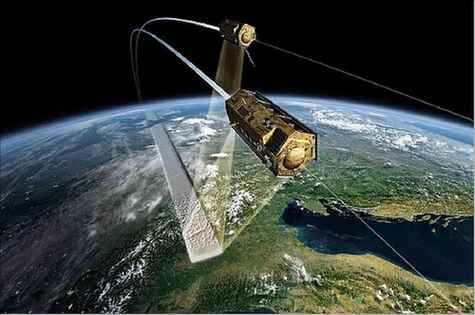 TerraSAR-X/TanDEM-X are belong to an interferometric SAR satellite mission, funded in a public/private collaboration between the German Aerospace Centre (DLR) and Airbus Defence and Space (formerly EADS Astrium GmbH). These two satellite launched in 15 Jun 2007 and 21 June 2010 and constructs three-dimensional images of Earth’s surface.
The mission includes a Tracking, Occultation and Ranging payload (TOR), which functions as a dual-frequency GPS receiver IGOR (Integrated GPS Occultation Receiver) that collects atmospheric radio occultation (RO) data to be used in the improvement of weather forecasting, climate change studies and space weather monitoring. The IGOR GPS receiver also has tracking capabilities that allow for precise orbit determination (POD) and works in conjunction with the Laser Retro Reflector (LRR) to evaluate GPS-based orbital data independently.
TerraSAR-X/TanDEM-X are belong to an interferometric SAR satellite mission, funded in a public/private collaboration between the German Aerospace Centre (DLR) and Airbus Defence and Space (formerly EADS Astrium GmbH). These two satellite launched in 15 Jun 2007 and 21 June 2010 and constructs three-dimensional images of Earth’s surface.
The mission includes a Tracking, Occultation and Ranging payload (TOR), which functions as a dual-frequency GPS receiver IGOR (Integrated GPS Occultation Receiver) that collects atmospheric radio occultation (RO) data to be used in the improvement of weather forecasting, climate change studies and space weather monitoring. The IGOR GPS receiver also has tracking capabilities that allow for precise orbit determination (POD) and works in conjunction with the Laser Retro Reflector (LRR) to evaluate GPS-based orbital data independently.
- Level 2
- Atmospheric profiles
Option 1: Access Data from HTTP server
| L2: Bending Angle and Refractivity | ||
|---|---|---|
| RO mission | STAR RFSI atmPrf (ICVS) |
STAR RFSI bfrPrf (ICVS) |
| COSMIC-2 | Download | Download |
| Spire | Download | Download |
| PlanetiQ | Download | Download |
| GeoOptics | Download | Download |
| GRAS Metop-B | Download | Download |
| GRAS Metop-C | Download | Download |
| KOMPSAT-5 | Download | Download |
| PAZ | Download | Download |
| TOR TerraSAR-X | Download | Download |
| TOR TanDem-X | Download | Download |
** ICVS: Integrated Calibration and Validation System for RO data
Option 2: Access Data from FTP server
ftp starro.umd.edu
username: anonymous
cd starro/data/romex/
## The directory structure is the same as on the HTTP server in option 1